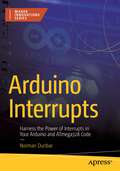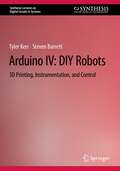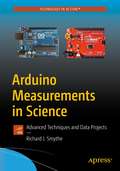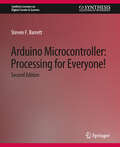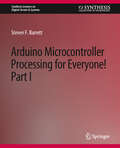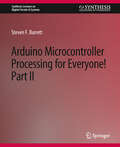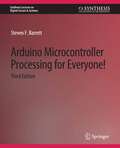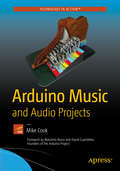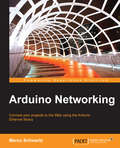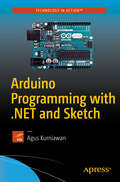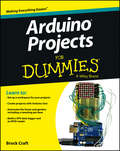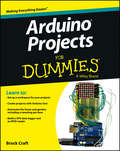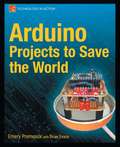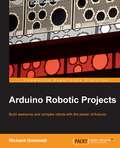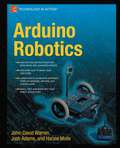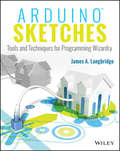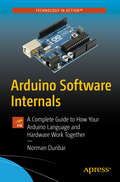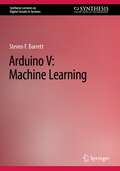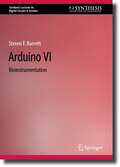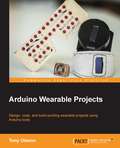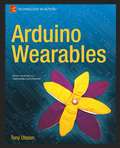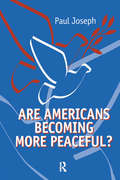- Table View
- List View
Arduino Interrupts: Harness the Power of Interrupts in Your Arduino and ATmega328 Code (Maker Innovations Series)
by Norman DunbarImprove your projects by leveraging the power of interrupts. This comprehensive guide makes it easy to understand and use interrupts with the ATmega328P microcontroller found on Arduino boards. With over 20 interrupts available, this book covers almost all of them and provides background information on how they work. You’ll work through the steps and code examples required to configure each of the covered interrupts. You'll also learn how to use them with Arduino, AVR C++ and with other development systems, like PlatformIO.Interrupts can be intimidating, but by the end of this book, you will have the knowledge and skills to take full advantage of them and improve the performance and efficiency of your Arduino projects. What You’ll Learn Understand interrupts and how they workMake interrupts easier to use in codeUse interrupts in their Arduino sketches or AVR C++ applicationsSee how to use interrupts in the Arduino Language and in AVR C++Avoid common pitfalls when working with interrupts Who This Book Is ForIntermediate to advanced-level programmers who want to learn how to use interrupts in their Arduino sketches or AVR C++ applications..
Arduino IoT Cloud for Developers: Implement best practices to design and deploy simple-to-complex projects at reduced costs
by Muhammad AfzalUnderstand essential IoT concepts to build smart IoT projects at reduced costs using the Arduino IoT Cloud platform, Arduino, ESP32 series boards, Amazon Alexa Voice Assistant, and MQT-135 with this practical guideKey FeaturesLearn about the Arduino IoT Cloud from scratch with hands-on projectsGain a solid understanding of IoT application development from basics to advanced featuresExplore the Arduino IoT Cloud’s capabilities for commercial IoT solutions in depthPurchase of the print or Kindle book includes a free PDF eBookBook DescriptionThe Arduino IoT Cloud offers a variety of features for building modern IoT solutions while reducing time and costs for prototyping and deployment. This book is a step-by-step guide, helping you master the powerful Arduino IoT Cloud ecosystem. This book begins by introducing you to the IoT landscape including its architecture, communication technologies, and protocols and then to the capabilities of the Arduino IoT Cloud platform and the Cloud Editor. With practical projects, such as monitoring air quality, building a portable asset tracker, and creating a remote alarm system using the LoRaWAN specification, you'll learn how to implement real-world IoT applications. Next, you'll explore communication between IoT devices and cloud platforms as well as the implementation of the Arduino IoT Cloud SDK and JavaScript for advanced customization. You'll also find out how to program IoT nodes, analyze the surrounding environment data, and visualize it on dashboards. Additionally, you’ll get to grips with advanced features such as task scheduling, synchronization, remote over-the-air updates for IoT nodes, and scripting with CCLI, through hands-on examples. By the end of this book, you’ll have learned how to work with the Arduino IoT Cloud platform and related hardware devices and will be able to develop industry-specific and cost-effective IoT solutions, such as smart homes and smart agriculture.What you will learnGain a solid understanding of IoT fundamentals and conceptsBuild creative IoT projects using Arduino MKR boards, Pulse sensors, and moreMaster various communication technologies, including LoRaWAN and 3G/4GHarness data exchange between IoT devices and cloud platforms using Zapier or IFTTTExplore advanced features like scheduling, over-the-air updates, and scriptingUnderstand easy-to-sync properties across multiple devices with no-codeDevelop voice-assisted home automation and heart rate tracking applicationsWho this book is forThis book is for aspiring IoT developers and seasoned professionals eager to harness the potential of Arduino and cloud integration as well as technology enthusiasts, students, and hobbyists interested in experimenting with IoT technologies. Prior knowledge of basic electronics and embedded systems, cloud computing, Arduino, and programming languages like C and JavaScript is needed.
Arduino IV: 3D Printing, Instrumentation, and Control (Synthesis Lectures on Digital Circuits & Systems)
by Tyler Kerr Steven BarrettThis book gives a step-by-step introduction to designing and building your own robots. As with other books in the Arduino series, the book begins with a quick overview of the Arduino Integrated Development Environment (IDE) used to write sketches, and the hardware systems aboard the Arduino UNO R3 and the Mega 2560 Rev 3. The level of the text makes it accessible for students, hobbyist and professionals' first introduction to both Arduino and Robotics. This book will be accessible by all levels of students, advanced hobbyists and engineering professionals, whether using as a self-reference or within a structure design laboratory. The text then examines the many concepts and characteristics common to all robots. In addition, throughout the book , reasonably priced, easily accessible and available off-the-shelf robots are examined. Examples include wheeled robots, tracked robots and also a robotic arm. After a thorough and easy to follow Arduino IDE and hardware introduction, the book launches into “do it yourself” or DIY concepts. A unique feature of the book is to start with a hands-on introduction to low cost 3D printing. These concepts will allow you to design and print your own custom robot parts and chassis. We then explore concepts to sense a robot's environment, move the robot about and provide a portable power source. We conclude with a several DIY robot projects.
Arduino Measurements in Science: Advanced Techniques and Data Projects
by Richard J. SmytheExplore the full capabilities of your Arduino. Whether you need to measure light, heat, mass, force, or conductivity, this book can be used as a complete reference guide for making virtually any scientific measurement with your PC or Linux based system and the Arduino microcontroller.You'll apply the Arduino and sensors to take measurements at the macro-, milli-, micro-, nano- and pico-sensitivity ranges. By working through the projects in this book, you’ll learn how to apply these techniques in the lab or field in areas such as weighing samples at the gram or milligram levels, measuring water temperature to a tenth of a degree, or its conductivity in milli or micro Siemens. With these projects, you can reliably measure, store, and experiment with a wide range of scientific data.Arduino Measurements in Science features a novel approach and several little known techniques to measure data that requires only basic and accessible hardware – perfect for the home or school workshop! What You’ll LearnMake basic scientific measurements with PCs, and Linux based computing systemsReview techniques for weighing measurements down into the double and even single digit milligramUse inexpensive sensors and displays to quantify and validate sensor dataIncorporate weighing scales, electrometers, magnetic and static field detectors, motion and vibration detectors, and moreUnderstand the possible noise and accuracy problems that can occur and best practices to refine your projects See the benefits of data validation for graphical data displayWho Is This Book ForReaders looking to acquire the basic science and engineering skills required to assemble fundamental measurement systems to implement with the simple hand tools found in most home or school workshops.
Arduino Microcontroller Processing for Everyone! (Synthesis Lectures on Digital Circuits & Systems)
by Steven BarrettThis book is about the Arduino microcontroller and the Arduino concept. The visionary Arduino team of Massimo Banzi, David Cuartielles, Tom Igoe, Gianluca Martino, and David Mellis launched a new innovation in microcontroller hardware in 2005, the concept of open source hardware. Their approach was to openly share details of microcontroller-based hardware design platforms to stimulate the sharing of ideas and promote innovation. This concept has been popular in the software world for many years. This book is intended for a wide variety of audiences including students of the fine arts, middle and senior high school students, engineering design students, and practicing scientists and engineers. To meet this wide audience, the book has been divided into sections to satisfy the need of each reader. The book contains many software and hardware examples to assist the reader in developing a wide variety of systems. For the examples, the Arduino UNO R3 and the Atmel ATmega328 is employed as the target processor. The second edition has been updated with the latest on the Arduino UNO R3 processor, changes to the Arduino Development Environment and several extended examples. Table of Contents: Getting Started / Programming / Embedded Systems Design / Serial Communication Subsystem / Analog to Digital Conversion (ADC) / Interrupt Subsystem / Timing Subsystem / Atmel AVR Operating Parameters and Interfacing
Arduino Microcontroller Processing for Everyone! Part I (Synthesis Lectures on Digital Circuits & Systems)
by Steven BarrettThis book is about the Arduino microcontroller and the Arduino concept. The visionary Arduino team of Massimo Banzi, David Cuartielles, Tom Igoe, Gianluca Martino, and David Mellis launched a new innovation in microcontroller hardware in 2005, the concept of open source hardware. Their approach was to openly share details of microcontroller-based hardware design platforms to stimulate the sharing of ideas and promote innovation. This concept has been popular in the software world for many years. This book is intended for a wide variety of audiences including students of the fine arts, middle and senior high school students, engineering design students, and practicing scientists and engineers. To meet this wide audience, the book has been divided into sections to satisfy the need of each reader. The book contains many software and hardware examples to assist the reader in developing a wide variety of systems. For the examples, the Arduino Duemilanove and the Atmel ATmega328 is employed as the target processor. Table of Contents: Getting Started / Programming / Embedded Systems Design / Serial Communication Subsystem / Analog to Digital Conversion (ADC) / Interrupt Subsystem / Timing Subsystem / Atmel AVR Operating Parameters and Interfacing
Arduino Microcontroller Processing for Everyone! Part II (Synthesis Lectures on Digital Circuits & Systems)
by Steven BarrettThis book is about the Arduino microcontroller and the Arduino concept. The visionary Arduino team of Massimo Banzi, David Cuartielles, Tom Igoe, Gianluca Martino, and David Mellis launched a new innovation in microcontroller hardware in 2005, the concept of open source hardware. Their approach was to openly share details of microcontroller-based hardware design platforms to stimulate the sharing of ideas and promote innovation. This concept has been popular in the software world for many years. This book is intended for a wide variety of audiences including students of the fine arts, middle and senior high school students, engineering design students, and practicing scientists and engineers. To meet this wide audience, the book has been divided into sections to satisfy the need of each reader. The book contains many software and hardware examples to assist the reader in developing a wide variety of systems. For the examples, the Arduino Duemilanove and the Atmel ATmega328 is employed as the target processor. Table of Contents: Getting Started / Programming / Embedded Systems Design / Serial Communication Subsystem / Analog to Digital Conversion (ADC) / Interrupt Subsystem / Timing Subsystem / Atmel AVR Operating Parameters and Interfacing
Arduino Microcontroller Processing for Everyone! Third Edition (Synthesis Lectures on Digital Circuits & Systems)
by Steven F. BarrettThis book is about the Arduino microcontroller and the Arduino concept. The visionary Arduino team of Massimo Banzi, David Cuartielles, Tom Igoe, Gianluca Martino, and David Mellis launched a new innovation in microcontroller hardware in 2005, the concept of open source hardware. Their approach was to openly share details of microcontroller-based hardware design platforms to stimulate the sharing of ideas and promote innovation. This concept has been popular in the software world for many years. This book is intended for a wide variety of audiences including students of the fine arts, middle and senior high school students, engineering design students, and practicing scientists and engineers. To meet this wide audience, the book has been divided into sections to satisfy the need of each reader. The book contains many software and hardware examples to assist the reader in developing a wide variety of systems. The book covers two different Arduino products: the Arduino UNO R3 equipped with the Atmel ATmega328 and the Arduino Mega 2560 equipped with the Atmel ATmega2560. The third edition has been updated with the latest on these two processing boards, changes to the Arduino Development Environment and multiple extended examples.
Arduino Music and Audio Projects
by Mike CookThis book is for musical makers and artists who want to gain knowledge and inspiration for your own amazing creations. “Grumpy Mike” Cook, co-author of several books on the Raspberry Pi and frequent answerer of questions of the Arduino forums, brings you a fun and instructive mix and simple and complex projects to help you understand how the Arduino can work with the MIDI system to create musical instruments and manipulate sound.In Part I you’ll find a set of projects to show you the possibilities of MIDI plus Arduino, covering both the hardware and software aspects of creating musical instruments. In Part II, you learn how to directly synthesize a wave form to create your own sounds with Arduino and concludes with another instrument project: the SpoonDuino. Finally, in Part III, you’ll learn about signal processing with the Arduino Uno and the Due — how to create effects like delay, echo, pitch changes, and realtime backwards audio output.If you want to learn more about how to create music, instruments, and sound effects with Arduino, then get on board for Grumpy Mike’s grand tour with Arduino Music and Sound Projects.
Arduino Networking
by Marco SchwartzThis book is intended for those who want to build their own network-connected projects using the Arduino platform. You will be able to build exciting projects that connect to your local network and the Web. You will need to have some basic experience in electronics and web programming languages. You will also need to know the basics of the Arduino platform as the projects mainly deal with the networking aspects of the Arduino Ethernet shield.
Arduino Programming with .NET and Sketch
by Agus KurniawanLeverage .NET and Sketch in your Arduino development implementation and integrate it into your .NET program.There are many Arduino models and compatible shields that can be used in Arduino boards. Integrating between an Arduino platform and .NET technology or Sketch can produce more advantages. Arduino Programming using .NET and Sketch shows readers how to do so with practical Arduino projects, such as preparing a development environment, performing sensing and actuating with external devices, implementing Windows Remote Arduino and building a simple IoT program. Use this quick reference to learn the basics of the Arduino platform for multiple models and start your Arduino programming in .NET and Sketch today. What You'll Learn:Learn the basics of the Arduino platformPrepare and set up an Arduino development environmentDevelop an Arduino program using .NET and Sketch Implement Windows Remote ArduinoBuild a simple IoT programWho This Book Is For:.NET and Sketch developers who want to learn Arduino programming.
Arduino Projects For Dummies
by Brock CraftDiscover all the amazing things you can do with Arduino Arduino is a programmable circuit board that is being used by everyone from scientists, programmers, and hardware hackers to artists, designers, hobbyists, and engineers in order to add interactivity to objects and projects and experiment with programming and electronics. This easy-to-understand book is an ideal place to start if you are interested in learning more about Arduino's vast capabilities. Featuring an array of cool projects, this Arduino beginner guide walks you through every step of each of the featured projects so that you can acquire a clear understanding of the different aspects of the Arduino board. Introduces Arduino basics to provide you with a solid foundation of understanding before you tackle your first project Features a variety of fun projects that show you how to do everything from automating your garden's watering system to constructing a keypad entry system, installing a tweeting cat flap, building a robot car, and much more Provides an easy, hands-on approach to learning more about electronics, programming, and interaction design for Makers of all ages Arduino Projects For Dummies is your guide to turning everyday electronics and plain old projects into incredible innovations. Get Connected! To find out more about Brock Craft and his recent Arduino creations, visit www.facebook.com/ArduinoProjectsForDummies
Arduino Projects For Dummies
by Brock CraftDiscover all the amazing things you can do with Arduino Arduino is a programmable circuit board that is being used by everyone from scientists, programmers, and hardware hackers to artists, designers, hobbyists, and engineers in order to add interactivity to objects and projects and experiment with programming and electronics. This easy-to-understand book is an ideal place to start if you are interested in learning more about Arduino's vast capabilities. Featuring an array of cool projects, this Arduino beginner guide walks you through every step of each of the featured projects so that you can acquire a clear understanding of the different aspects of the Arduino board. Introduces Arduino basics to provide you with a solid foundation of understanding before you tackle your first project Features a variety of fun projects that show you how to do everything from automating your garden's watering system to constructing a keypad entry system, installing a tweeting cat flap, building a robot car, and much more Provides an easy, hands-on approach to learning more about electronics, programming, and interaction design for Makers of all ages Arduino Projects For Dummies is your guide to turning everyday electronics and plain old projects into incredible innovations. Get Connected! To find out more about Brock Craft and his recent Arduino creations, visit www.facebook.com/ArduinoProjectsForDummies
Arduino Projects to Save the World
by Emery Premeaux Brian EvansArduino Projects to Save the World shows that it takes little more than a few tools, a few wires and sensors, an Arduino board, and a bit of gumption to build devices that lower energy bills, help you grow our own food, monitor pollution in the air and in the ground, even warn you about earth tremors. Arduino Projects to Save the World introduces the types of sensors needed to collect environmental data—from temperature sensors to motion sensors. You'll see projects that deal with energy sources—from building your own power strip to running your Arduino board on solar panels so you can actually proceed to build systems that help, for example, to lower your energy bills. Once you have some data, it's time to put it to good use by publishing it online as you collect it; this book shows you how. The core of this book deals with the Arduino projects themselves: Account for heat loss using a heat loss temperature sensor array that sends probes into every corner of your house for maximum measurement. Monitor local seismic activity with your own seismic monitor. Keep your Arduino devices alive in the field with a solar powered device that uses a smart, power-saving design. Monitor your data and devices with a wireless radio device; place your sensors where you like without worrying about wires. Keep an eye on your power consumption with a sophisticated power monitor that records its data wherever you like. Arduino Projects to Save the World teaches the aspiring green systems expert to build environmentally-sound, home-based Arduino devices. Saving the world, one Arduino at a time. Please note: the print version of this title is black & white; the eBook is full color.
Arduino Robotic Projects
by Richard GrimmettThis book is for anyone who has been curious about using Arduino to create robotic projects that were previously the domain of research labs of major universities or defense departments. Some programming background is useful, but if you know how to use a PC, you can, with the aid of the step-by-step instructions in this book, construct complex robotic projects that can roll, walk, swim, or fly.
Arduino Robotics
by John-David Warren Josh Adams Harald MolleThis book will show you how to use your Arduino to control a variety of different robots, while providing step-by-step instructions on the entire robot building process. You'll learn Arduino basics as well as the characteristics of different types of motors used in robotics. You also discover controller methods and failsafe methods, and learn how to apply them to your project. The book starts with basic robots and moves into more complex projects, including a GPS-enabled robot, a robotic lawn mower, a fighting bot, and even a DIY Segway-clone. Introduction to the Arduino and other components needed for robotics Learn how to build motor controllers Build bots from simple line-following and bump-sensor bots to more complex robots that can mow your lawn, do battle, or even take you for a ride Please note: the print version of this title is black & white; the eBook is full color.
Arduino Sketches: Tools and Techniques for Programming Wizardry
by James A. LangbridgeMaster programming Arduino with this hands-on guide Arduino Sketches is a practical guide to programming the increasingly popular microcontroller that brings gadgets to life. Accessible to tech-lovers at any level, this book provides expert instruction on Arduino programming and hands-on practice to test your skills. You'll find coverage of the various Arduino boards, detailed explanations of each standard library, and guidance on creating libraries from scratch – plus practical examples that demonstrate the everyday use of the skills you're learning. Work on increasingly advanced programming projects, and gain more control as you learn about hardware-specific libraries and how to build your own. Take full advantage of the Arduino API, and learn the tips and tricks that will broaden your skillset. The Arduino development board comes with an embedded processor and sockets that allow you to quickly attach peripherals without tools or solders. It's easy to build, easy to program, and requires no specialized hardware. For the hobbyist, it's a dream come true – especially as the popularity of this open-source project inspires even the major tech companies to develop compatible products. Arduino Sketches is a practical, comprehensive guide to getting the most out of your Arduino setup. You'll learn to: Communicate through Ethernet, WiFi, USB, Firmata, and Xbee Find, import, and update user libraries, and learn to create your own Master the Arduino Due, Esplora, Yun, and Robot boards for enhanced communication, signal-sending, and peripherals Play audio files, send keystrokes to a computer, control LED and cursor movement, and more This book presents the Arduino fundamentals in a way that helps you apply future additions to the Arduino language, providing a great foundation in this rapidly-growing project. If you're looking to explore Arduino programming, Arduino Sketches is the toolbox you need to get started.
Arduino Sketches: Tools and Techniques for Programming Wizardry
by James A. LangbridgeMaster programming Arduino with this hands-on guide Arduino Sketches is a practical guide to programming the increasingly popular microcontroller that brings gadgets to life. Accessible to tech-lovers at any level, this book provides expert instruction on Arduino programming and hands-on practice to test your skills. You'll find coverage of the various Arduino boards, detailed explanations of each standard library, and guidance on creating libraries from scratch – plus practical examples that demonstrate the everyday use of the skills you're learning. Work on increasingly advanced programming projects, and gain more control as you learn about hardware-specific libraries and how to build your own. Take full advantage of the Arduino API, and learn the tips and tricks that will broaden your skillset. The Arduino development board comes with an embedded processor and sockets that allow you to quickly attach peripherals without tools or solders. It's easy to build, easy to program, and requires no specialized hardware. For the hobbyist, it's a dream come true – especially as the popularity of this open-source project inspires even the major tech companies to develop compatible products. Arduino Sketches is a practical, comprehensive guide to getting the most out of your Arduino setup. You'll learn to: Communicate through Ethernet, WiFi, USB, Firmata, and Xbee Find, import, and update user libraries, and learn to create your own Master the Arduino Due, Esplora, Yun, and Robot boards for enhanced communication, signal-sending, and peripherals Play audio files, send keystrokes to a computer, control LED and cursor movement, and more This book presents the Arduino fundamentals in a way that helps you apply future additions to the Arduino language, providing a great foundation in this rapidly-growing project. If you're looking to explore Arduino programming, Arduino Sketches is the toolbox you need to get started.
Arduino Software Internals: A Complete Guide to How Your Arduino Language and Hardware Work Together
by Norman DunbarIt’s not enough to just build your Arduino projects; it’s time to actually learn how things work! This book will take you through not only how to use the Arduino software and hardware, but more importantly show you how it all works and how the software relates to the hardware.Arduino Software Internals takes a detailed dive into the Arduino environment. We’ll cover the Arduino language, hardware features, and how makers can finally ease themselves away from the hand holding of the Arduino environment and move towards coding in plain AVR C++ and talk to the microcontroller in its native language. What You’ll Learn:How the Arduino Language interfaces with the hardware, as well as how it actually works in C++;How the compilation system works, and how kit can be altered to suit personal requirements;A small amount of AVR Assembly Language;Exactly how to set up and use the various hardware features of the AVR without needing to try and decode the data sheets – which are often bug ridden and unclear;Alternatives to the Arduino IDE which might give them a better workflow;How to build their own Arduino clone from scratch.Who This Book Is For: No expertise is required for this book! All you need is an interest in learning about what you’re making with Arduinos and how they work. This book is also useful for those looking to understand the AVR microcontroller used in the Arduino boards. In other words, all Makers are welcome!
Arduino V: Machine Learning (Synthesis Lectures on Digital Circuits & Systems)
by Steven F. BarrettThis book is about the Arduino microcontroller and the Arduino concept. The visionary Arduino represented a new innovation in microcontroller hardware in 2005, the concept of open source hardware, making a broad range of computing accessible for all.This book, “Arduino V: AI and Machine Learning,” is an accessible primer on Artificial Intelligence and Machine Learning for those without a deep AI and ML background. The author concentrates on Artificial Intelligence (AI) and Machine Learning (ML) applications for microcontroller–based systems. The intent is to introduce the concepts and allow readers to practice on low cost, accessible Arduino hardware and software. Readers should find this book a starting point, an introduction, to this fascinating field. A number of references are provided for further exploration.
Arduino VI: Bioinstrumentation (Synthesis Lectures on Digital Circuits & Systems)
by Steven F. BarrettThis book is about the Arduino microcontroller and the Arduino concept. The visionary Arduino team represented a new innovation in microcontroller hardware in 2005, the concept of open source hardware, making a broad range of computing accessible for all. This book, “Arduino VI: Bioinstrumentation,” is an accessible primer on bioinstrumentation for those without a deep instrumentation background. An understanding of basic circuit theory is an appropriate prerequisite for the book. The three main goals for the book are: explore accessible Arduino microcontroller programming and interfacing concepts; investigate the source and measurement of biomedical signals; and develop skills to design and implement biomedical instrumentation.
Arduino Wearable Projects
by Tony OlssonDesign, code, and build exciting wearable projects using Arduino tools About This Book • Develop an interactive program using sensors and actuators suitable with wearables • Understand wearable programming with the help of hands-on projects • Explore different wearable design processes in the Arduino platform and customize them to fit your individual needs Who This Book Is For This book is intended for readers who are familiar with the Arduino platform and want to learn more about creating wearable projects. No previous experience in wearables is expected, although a basic knowledge of Arduino programming will help. What You Will Learn • Develop a basic understanding of wearable computing • Learn about Arduino and its compatible prototyping platforms suitable for creating wearables • Understand the design process surrounding the creation of wearable objects • Gain insight into the materials suitable for developing wearable projects • Design and create projects including interactive bike gloves, GPRS locator watch, and more using various kinds of electronic components • Discover programming for interactivity • Learn how to connect and interface wearables' with Bluetooth and WiFi • Get your hands dirty with your own personalized designs In Detail The demand for smart wearable technologies is becoming more popular day by day. The Arduino platform was developed keeping wearables, such as watches that track your location or shoes that count the miles you've run, in mind. It is basically an open-source physical computing platform based on a simple microcontroller board and a development environment in which you create the software for the board. If you're interested in designing and creating your own wearables, this is an excellent platform for you. This book provides you with the skills and understanding to create your own wearable projects. The book covers different prototyping boards which are compatible with the Arduino platform and are suitable for creating wearable projects. Each chapter of the book covers a project in which knowledge and skills are introduced gradually, making the book suitable for all kinds of readers. You begin your journey with understanding electronic components, including LEDs and sensors, to get yourself up to scratch and comfortable with different components. You will then gain hands-on experience by creating your very first wearable project, a pair of interactive bike gloves that help you cycle at night. This is followed by a project making your own funky LED glasses and a cool GPS watch. You'll also delve into other projects including creating your own keyless doorlock, wearable NFC tags, a fitness-tracking device, and a WiFi-enabled spark board. The final project is a compilation of the previous concepts used where you make your own smart watch with fitness tracking, internet-based notifications, GPS, and of course time telling. Style and approach This is a project-based book that introduces each project to the reader step-by-step. Each project starts out by covering all the components individually, and then explains how to combine them into interactive objects. Each project contains an easy-to-follow guide to design and implement the electronics into wearable objects.
Arduino Wearables
by Tony OlssonYou've probably seen LED-decorated t-shirts and hats, and maybe even other electronic gadgets embedded in clothing, but with Arduino Wearables you can learn to make your own wearable electronic creations. This book is an introduction to wearable computing, prototyping, and smart materials using the Arduino platform. Every chapter takes you all the way from idea to finished project. Even if you have no experience with Arduino, this book will get you set up with all the materials, software, and hardware you need; you'll complete simple projects first, and then build on your growing expertise to make more complex projects. By the end of the book, you'll have learned: Electronics basics How to prototype successfully Arduino programming How to design and build your own wearable Arduino creations Along the way you'll create fun and inspiring wearables, such as: An LED bracelet: learn the basics of wearable electronics A synthesizer tie: accept user input and create output in response A solar-powered glow in the dark bag: create self-sufficient wearables A shape memory flower: store state and manipulate your wearables An EL wire dress: add designer touches to your wearables A beatbox hoodie: use a voice-activated sequencer and skin resistance to create the coolest of urban wearables Arduino Wearables is the complete guide to getting started with Arduino and wearable computing. The 10 inspiring projects to make, learn from, and build upon will equip you for creating your own projects; the only limit is your imagination.
Are Americans Becoming More Peaceful?
by Paul Joseph"It's time that someone broke into the general gloom created by a war-loving administration and reminded us that we are a peace-loving people. Paul Joseph's book does just that, not with fantasy but with facts, showing how the public antipathy to war, suppressed too long by propaganda and deception, is coming to the surface, and offers hope." Howard Zinn "In this antidote to despair, Joseph shows how even the most sophisticated efforts of US political and military leaders to maintain public support for war are flawed and doomed to failure in the face of an increasingly skeptical public that is unwilling to accept the costs." William A. Gamson, Boston College "An original and thought-provoking perspective on one of the most important issues in American politics today." Michael Klare, Hampshire College Are Americans becoming more peaceful -- even after the 2004 elections and the seeming affirmation of the war in Iraq? This book looks at the meaning of peace in the face of war and offers an optimistic interpretation of the public's changing views. US citizens are becoming increasingly uncomfortable with the costs of war that can be measured not just in dollars but in lives and international respect. Americans are becoming ever more resistant to government management of the "facts" surrounding war. In areas ranging from media and photojournalism to gender and casualties, Joseph exposes the reality of popular opposition to war.
Are Americans Becoming More Peaceful?
by Paul Joseph"It's time that someone broke into the general gloom created by a war-loving administration and reminded us that we are a peace-loving people. Paul Joseph's book does just that, not with fantasy but with facts, showing how the public antipathy to war, suppressed too long by propaganda and deception, is coming to the surface, and offers hope." Howard Zinn "In this antidote to despair, Joseph shows how even the most sophisticated efforts of US political and military leaders to maintain public support for war are flawed and doomed to failure in the face of an increasingly skeptical public that is unwilling to accept the costs." William A. Gamson, Boston College "An original and thought-provoking perspective on one of the most important issues in American politics today." Michael Klare, Hampshire College Are Americans becoming more peaceful -- even after the 2004 elections and the seeming affirmation of the war in Iraq? This book looks at the meaning of peace in the face of war and offers an optimistic interpretation of the public's changing views. US citizens are becoming increasingly uncomfortable with the costs of war that can be measured not just in dollars but in lives and international respect. Americans are becoming ever more resistant to government management of the "facts" surrounding war. In areas ranging from media and photojournalism to gender and casualties, Joseph exposes the reality of popular opposition to war.
